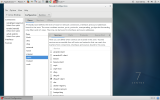| « I now understand why Roger's has capped our Internet | Lazyfeed, for people too lazy to find blogs to read » |
WebcamStudio for Linux, not quite WebcamMax but a good start
08/03/09
(updated Aug. 24th with sample video and additions marked below)
Until WebcamStudio came along Linux webcam users could only look longingly at the neat effects available to Windows users with WebcamMax. Even if you don't have a webcam you can use the desktop capture functionality to help with how to videos. WebcamStudio for Linux can also play video and be used as a budget switcher either to make your own videos or stream to Ustream.com or another one of the online video services if you have the vloopback module installed in your system. The vloopback module is a handy tool and is included with the Webcamstudio release.
This program shows lots of potential but is still a work in progress. It's written in java and on my Pentium 4 2.4 Ghz machine it wasn't very responsive especially when I had the webcam and the screen capture active. The text overlays in version 0.43 which is what I downloaded and the previous which I also downloaded, wouldn't change size no matter which font or size I selected. The animation and faces files disappeared from the project website before I got around to downloading and trying them. Whenever I try to play a movie as an input I get a Gstreamer error. I suspect this is because Centos 5 doesn't run the latest and greatest version of Gstreamer. I was going to do a short demo video but the audio capture on my PC has crapped out yet again. I'm not sure if it's the old Soundblaster Audigy sound card I have installed or something that gets goofed up in the ALSA subsystem but occasionally the analog audio capture stops working and no amount of fiddling with mixer setting will get it going again. I tried doing a video with the mic on the webcam but it dropped out after only a few seconds of recording, generally when I started the webcam capture. I resolved this by switching to saving the video as a 320x240 avi instead of 640x480. The documentation that comes with is minimalist at best. Sound synchronization can be done using the pulse audio server which I haven't got running as of yet. That and the irritating tendency of ALSA to rearrange devices based on what's plugged in at boot time makes me want to pull what little hair I have left out. Linux audio can be very frustrating at times.
If I haven't scared you away I'd be interested in hearing your experiences with WebcamStudio for GNU/Linux. Go ahead, I dare you.
2 comments
Massive changes, upgrades and updates have been made to the software. Would encourage you to take another look at what’s changed. ;)
We also have completely revamped the documentation as well at ws4gl.org
Good article. I would recommend more friends to come by.
